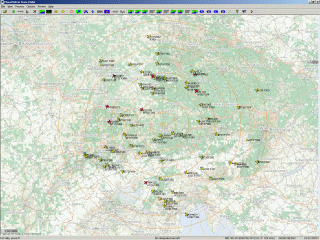Performance:
I am quite proud that the Mode-S Beast is around the
best-in-class
Mode-S units that is available, if not even that it is the best. I do
not compare the Mode-S Beast against any of the PIC solutions or such
without an ADC. So there is only one unit that I can compare it to, and
during the last few month I had the chance to verify my development
three times against another commercial unit.
During the
first test in
January 2011 I had both units connected to my G7RGQ omni
antenna through a 6dB splitter.
Let me
say a word to the two Planeplotter screenshots:I
have to admit that I do not completly understand why there is such a
big difference between the number of planes beeing displayed within the
same time interval. I unfortunately did not compare the frames that
both
units have provided to Planeplotter, so I
may explain that
the 15% more frames of the Mode-S Beast are just from those planes
displayed additionally.
This plus with planes also happens in situations when both units show
nearly same frame rate. It might also be that the software of the other unit
does
not
forward all planes to the Planeplotter interface. Anyway, I do not have
time to check this further, and finally I am happy that my Mode-S Beast
is the better one.
The second test
was the most
intensive, because one of the users of the evaluation units was not
able to reproduce my frame rate. It figured out that he used an magnet
mounted antenna on the window sill, such antennas are quite often used.
Luckily I got his complete equipment and so I was able to reproduce his
issue, and finally solve it: At that time the receiver was not in a box
and so there was feedback from the receiver to the antenna. I
solved this by putting the receiver into a screening box, and also the
unit shown above behaves as above. So be aware that if you are using
close-by antennas, your receiver must be screened in order to give
maximum performance.

I swapped the antenna (mag mount on windowsill)
between the two receivers while they were connected to ModeSCompare.
Result:
Both units showing same number of frames.
(There are not more frames displayed by the Mode-S Beast, because there
just were no more planes it could see from that position) |

Again, I did the 30sec run of Planeplotter connected to the
other unit first and immediately afterwards to the Mode-S Beast.
For this I
used my G7RGQ omni on the rooftop.
Low
altitude traffic is masked here, and notice
that total number of planes received was 140. |

And here I can show again more planes on the screen when running
Planeplotter connected to the Mode-S Beast.
Also note that here I got a total of 167 planes.
|

The effect of the 2nd antenna can be shown here, when I
connected
the 2nd receiver with a yagi towards Munich airport to the 2nd port for
a short moment during the second test.
The maximum DF-11#/DF-17 frame number ever seen with two
antennas was 400 per second.
|

The Mode-S Beast in a screened box that was used to solve the issue of
the second
test.
The small screening box above the receiver part did not solve the
issue, but
it is an example what will be needed for Bluetooth interface.
The box that is delivered with the box kit also does a sufficient
screening.
|

Here I swapped my omni anenna between the two devices under test.
The plus for the Mode-S Beast is less than in all tests, maybe there
were no planes in the area that the Mode-S Beast is able to receive
additionally during the test.
At the end you can see the effect of the CRC Bit error correction driver
which improves the frame rate by about 40%. |
The third test
was done somewhere
in northern europe,
and I just swapped the antenna between the Mode-S Beast and the other
unit under test. I had two Mode-S beasts with me, one development
version V0.1 and one V1.0 engineering sample , both showed the same
data.

Again, there is a 15-20% higher frame rate shown for the
Mode-S Beast.









